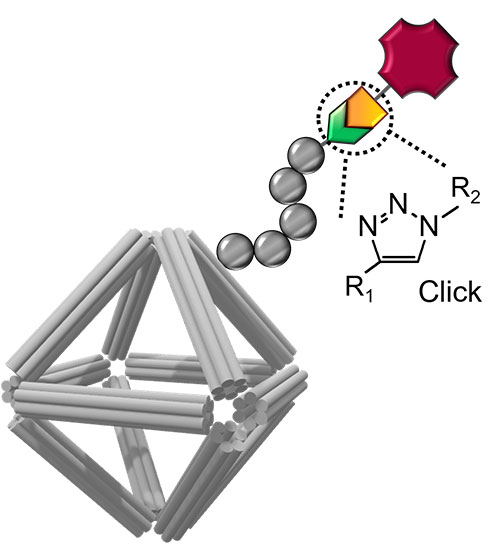Tunable Molecular Coating Stabilizes “DNA Origami” Structures
03/24/2020

Schematic of a DNA origami stabilized by a peptoid coating and equipped with imaging and cell-targeting capabilities. Click chemistry was used to conjugate functional molecules on the peptoid/origami surface. [Reprinted under a Creative Commons Attribution NonCommercial NoDerivatives 4.0 International (CC BY-NC-ND 4.0) from Wang, S.-T., et al. 2020. "DNA origami protection and molecular interfacing through engineered sequence-defined peptoids." Proceedings of the National Academy of Sciences, 117 (12) 6339-6348. DOI:10.1073/pnas.1919749117.]
DNA nanotechnology provides a structural toolkit for the fabrication of programmable DNA nano-constructs through the folding of long, flexible DNA chains into desired shapes at the nanoscale. However, the use of such nano-constructs, known as “DNA origami” structures, in biomedical applications is challenging due their limited structural integrity in complex biological fluids.
Researchers report a class of tailorable molecular coatings, called peptoids, which can efficiently stabilize three-dimensional wireframed DNA constructs under a variety of biomedically relevant conditions, including magnesium-ion depletion and presence of degrading nuclease. The peptoid-coated DNA constructs offered a controllable anticancer drug release and an ability to display functional biomolecules on the DNA surfaces.
The study demonstrates an approach for building multifunctional and environmentally robust DNA-based molecular structures for nanomedicine and biosensing.
Related Links
- BER Resource: Center for BioMolecular Structure
- Feature Story: Fighting Cancer with DNA Origami
- News: Protecting DNA Origami for Anti-Cancer Drug Delivery
References
S.-T. Wang, M. A. Gray, S. Xuan, Y. Lin, J. Byrnes, A. I. Nguyen, N. Todorova, M. M. Stevens, C. R. Bertozzi, R. N. Zuckermann, O. Gang. “DNA origami protection and molecular interfacing through engineered sequence-defined peptoids.” Proceedings of the National Academy of Sciences, 117 (12) 6339-6348 (2020); [DOI: 10.1073/pnas.1919749117]
